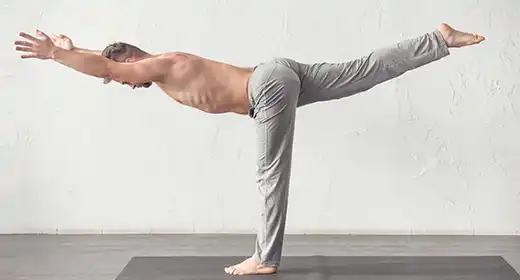byHimanshu Joshi: Position : Standing Type : Grounding Spiritual Awareness : Manipura
Physical Awareness : Ankles, legs, abdomen, shoulder, muscles of the back
Dosha Suitability : Vata
Introductory Asanas : Ardha chandrasana, Supta padangusthasana, Supta virasana, Utkatasana, Vrikshasana
Procedure:
- Stand in Tadsana (Mountain Pose), exhale and bend forward to Uttasana. From Uttasaana, exhale and step your left foot back into a high lunge position. Your right knee should be more or lss at a right angle. Lay the midline of your torso (from the pubis to the sternum) down on the midline of the right thigh (from the knee to the tip crease) and your bring hands to your right knee, right hand to the outer knee, left hand to the inner. Squeeze the knee with your hands, lift your torso slightly and with an exhalation, turn it slightly to the right.
- Now from the lunge position, stretch your arms forward, parallel to the floor and parallel to each other, palms facing each other. Exhale and press the head of the right thighbone back and press the heel actively into the floor. Synchronize the straightening of the front leg and the lifting of the back leg. As you lift the back leg, resist by pressing the tailbone into the pelvis.
- Normally students come up into Virabhadrasana III by lunging the torso forward. This tends to shift the body weight onto the ball of the front foot and unbalance the position. Don’t allow the torso to swing forward as you move into position; instead as you straighten the front knee, think of pressing the head of the thighbone back. This centres the femur in the hip joint, grounds the heel into the floor, and stabilizes the position.
- The arms, torso, and raised leg should be positioned relatively parallel to the floor. For many students the pelvis tends to tilt. Release the hip [of the raised leg] toward the floor until the two hip points are even and parallel to the floor. Energize the back leg and extend it strongly toward the wall behind you; reach just as actively in the opposite direction with the arms. Bring the head up slightly and look forward, but be sure not to compress the back of your neck.
- Stay in this position for 30 seconds to a minute. Release back to the lunge on an exhalation. Bring your hands to the floor on either side of the right foot, and on an exhalation, step your left foot forward to meet your right. Stay in this forward bend for a few breaths, then repeat for the same length of time on the other side.
- Note: Advanced students can enter Virabhadrasana III from Virabhadrasana I. Perform the warrior I with the arms stretched upward. Exhale the front torso down onto the top of the forward leg. From here move into Virabhadrasana III as described in Step 3 above.
Variation: In the Virabhadrasana III you can vary the position of your arms. Try stretching the arms out to the sides, like the wings of an airplane, or reaching them back, palms facing up, along the sides of your torso.
Spotlight effects: Ankles, legs, abdomen, shoulder, muscles of the back.
Followup asanas: Halasana, Hanumanasana, Natarajasana, Salamba Shirsasana, Eka pada rajakapotasana.
Physical Benefits:
- Strengthens the ankles and legs.
- Strengthens the shoulders and muscles of the book.
- Tones the abodemen.
- Improves balance and posture.
Therapeutic Benefits:
- Relieves backaches, especially through second trimester of pregnancy.
- Therapeutic for carpal tunnel syndrome, flat feet, infertility, osteoporosis, and sciatica.
Precautions and Contraindications:
- When you straighten the front knee by pushing the head of the thighbone back, imagine that the same- leg calf is resisting forward against the shin. These two opposing movements prevent the knee from locking or hyperextending and further stabilize the position.
- High blood pressure.








































